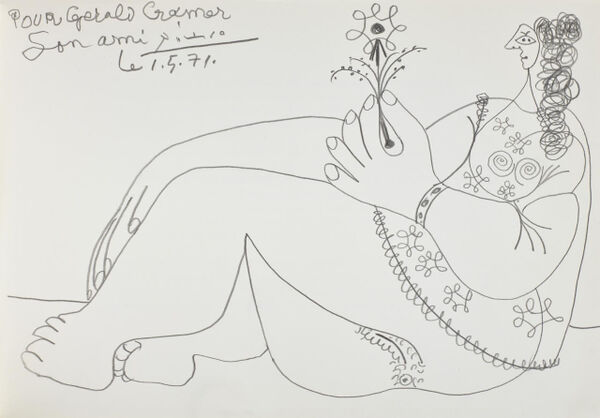Pablo Picasso
(Spanish, 1881-1973)
"That the position held by us now could have been delayed or lost depended only on a failure in the determination of [Pablo Picasso]. His admirable perseverance was for us such a valuable pledge that we do not need to recur to any other authority."
- André Breton, Le Surréalisme et la Peinture, 1928.
Visionary Pablo Picasso, born to an art teacher in Málaga, Spain on October 25, 1881, displayed prodigious aptitude for painting before he was even 10 years old. Considering his natural artistic talent in conjunction with his creative fearlessness, it is no surprise that the Spanish painter is heralded as the most important contributor to and influence on 20th century painting. After attending the Academies of Barcelona and Madrid, Picasso's artistic practice led him to Paris, where he signed a contract with Catalan art deal Père Manyac at the young age of 19 and began his well-known Blue and Rose Periods. He settled in bohemian Montmartre in April 1904, only three years before he discovered Cubism.
The proto-Cubist Les Demoiselles d'Avignon,1907, clearly demonstrates Picasso's rebellious rupture of classical perspective and his grotesque division of the human body into geometrical planes, both stylistic choices he would continue to explore in his painting until his death. He and fellow painter Georges Braque, whom he met in 1907, continually transcended the boundaries of classical perspective as they developed Analytical Cubism, Synthetic Cubism and Cubist collage through the 1910s. Picasso was discovered Surrealism upon meeting André Breton after World War I and even began exhibiting with the Surrealists in 1925, but he was too independent-minded to officially join the group. He started making sculpture after meeting Catalan sculptor Juli González and continued to sculpt through the 1960s.
During the 1930s he illustrated works by Balzac and Ovid, and created the Vollard Suite, a series of etches produced in a neoclassical style. He returned to Spain for a brief period in 1934, two years before the start of the Spanish Civil War, but returned to France once the war began. In 1937 the Republican government of Spain commissioned Picasso to make Guernica in response to the horrific destruction of the Basque city. It remains his most well-known painting to this day.
He was one of the few painters who remained in France through World War II. During the 1940's he notably explored numerous artistic mediums, including playwriting, lithography and pottery, and demonstrated his artistic versatility until the end of his life. In 1957 he painted a version of Diego Velázquez' prolific Las Meninas and eventually gifted the painting to the Picasso Museum in Barcelona in 1968. Despite suffering from illness during the 1960s, he remained politically engaged and continued to produce work until he died in Mougins, France in 1973.

